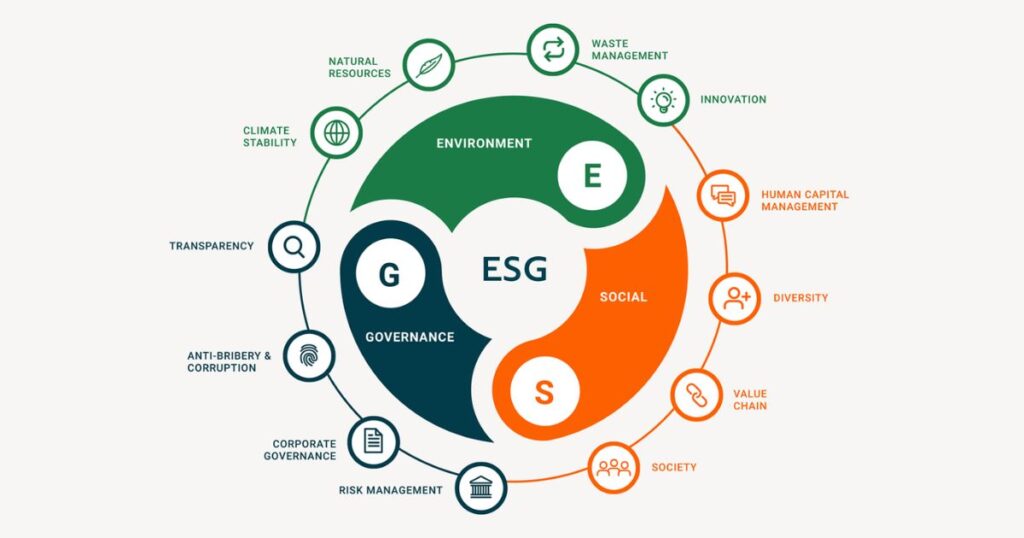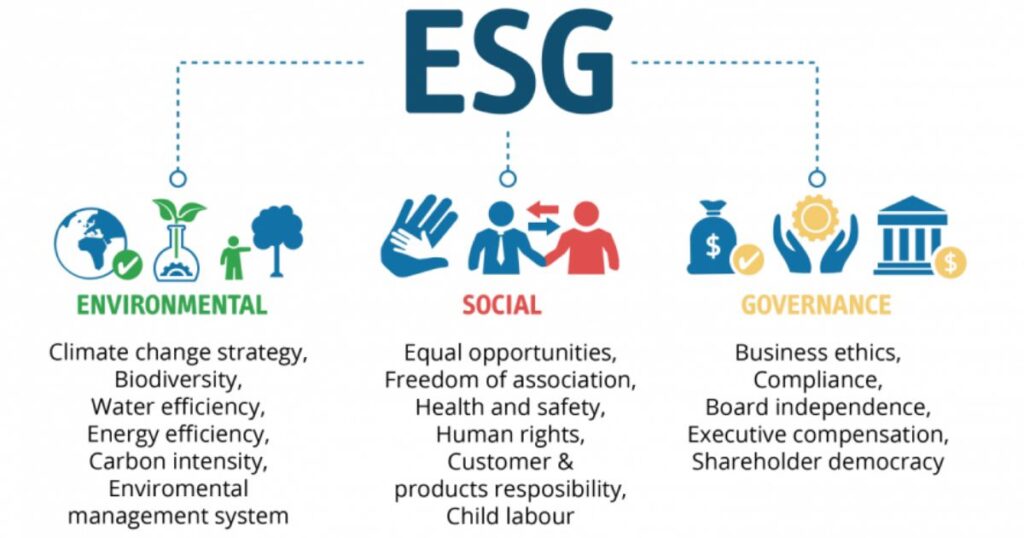In 2024, having a clear ESG strategy is no longer optional. Businesses in the USA and across the world are being pushed by investors, consumers, and regulators to adopt more sustainable and ethical practices.
Companies that don’t have a solid sustainable plan in place may face risks, from reputational damage to financial penalties. This guide will walk you through everything you need to know about developing a comprehensive ESG framework for your business.
ESG factors like climate impact, social responsibility, and ethical management are driving the future of business. An ESG strategy can help you meet expectations, reduce risks, and improve your bottom line. This guide will help you understand the responsible framework you need to build in 2024.
What is an ESG Strategy?
An ESG strategy is a framework that helps businesses address environmental, social, and governance (ESG) factors. It guides how a company operates and makes decisions in a way that benefits both the business and society.
It’s not just about making money; it’s about being a responsible business that cares about its environmental footprint, social responsibility, and ethical practices. The goal of an ESG framework is to create a sustainability plan that benefits all stakeholders, including investors, employees, and customers.
It aligns with business transparency, stakeholder relations, and long-term business sustainability. Companies with strong ESG strategies often outperform their peers because they build trust and risk management into their operations.
Why is an ESG Strategy Important?
Having an ESG strategy is critical for several reasons. First, it helps your company stay compliant with regulatory adherence and industry regulations. In the USA, many businesses are required to follow strict standards of compliance on issues like greenhouse gases, carbon reduction, and sustainability reporting. Failing to meet these regulations can lead to legal issues and financial penalties.
Second, an ESG strategy builds stakeholder trust by showing that your company values social responsibility and ethical management. When stakeholders see that you have a clear corporate policy on eco-friendly operations and business transparency, it boosts your reputation.
Companies that embrace green practices and ethical business are also better equipped to identify new opportunities in green investment and sustainable finance.
Why Have ESG Strategies Come About?

ESG strategies have become more important over the years for two major reasons. First, businesses realize that addressing sustainability efforts and social responsibility can help them avoid risks and identify new opportunities.
Investors now expect businesses to demonstrate their commitment to responsible investment and sustainable development. Companies that fail to show this commitment may lose out on valuable ESG investment.
The second reason is regulatory compliance. Governments worldwide have started mandating non-financial disclosure on ESG factors. For example, the European Union’s Corporate Sustainability Reporting Directive (CSRD) requires companies to report their carbon footprint, energy management, and other sustainability efforts. This shift toward CSR reporting means that companies must adopt ESG strategies to remain competitive in global markets.
What Makes Up an ESG Strategy?
An ESG strategy is divided into three parts: environmental, social, and governance. These elements create a comprehensive framework for addressing a company’s impact on the planet, people, and business operations.
Environmental
The environmental part of an ESG strategy focuses on a company’s climate impact and how it manages its environmental footprint. This includes reducing greenhouse gases, improving energy savings, and enhancing waste management. Companies must adopt power efficiency measures and focus on resource conservation.
Governments are pushing companies to report on carbon reduction and pollution levels as part of regulatory compliance. Companies with strong eco-efficiency strategies can also reduce costs and improve long-term sustainability.
Social
The social aspect addresses how businesses interact with people and communities. It involves community engagement, diversity and inclusion, and working conditions. Companies are expected to ensure social responsibility by adopting fair labor standards, maintaining data security, and practicing corporate citizenship.
Social factors also include how a company works with its suppliers and how it supports local outreach. By focusing on social impact, companies can build stronger relationships with their stakeholders, which is critical for long-term success.
Governance
The governance part of an ESG strategy involves the leadership and management of a company. It includes setting up a strong compliance policy, ensuring accounting transparency, and practicing ethical management. Companies need clear policies on executive compensation, board member composition, and stockholder voting rights.
Good governance also involves risk management and ensuring that the company’s leaders are accountable for their actions. Business transparency in governance helps to build stakeholder trust and ensures that the company operates with ethical business practices.
Examples of an ESG Strategy
One of the most notable examples of a strong ESG strategy comes from Microsoft. In 2020, the tech giant set ambitious goals to become carbon-negative, water-positive, and zero waste by 2030. Microsoft’s commitment to resource conservation and recycling shows how a company can lead in sustainable development.
Their sustainability plan also focuses on protecting ecosystems and reducing their climate impact through eco-friendly operations. This kind of leadership in ESG factors is helping Microsoft set a benchmark for the industry.
Carbon Negative
Carbon negative means a company removes more carbon from the atmosphere than it produces. Microsoft’s goal to become carbon-negative involves reducing its greenhouse gases and investing in technologies that absorb carbon from the atmosphere.
Water Positive
Being water-positive means that a company restores more water than it consumes. Microsoft is focused on water conservation by recycling water and improving disposal methods.
Zero Waste
Zero waste means that a company sends no waste to landfills, instead focusing on recycling and adopting a circular economy approach. Microsoft is striving to achieve this goal by 2030.
Protect and Preserve Ecosystems
Preserving ecosystems is another core goal of Microsoft’s ESG strategy. This involves resource conservation and ensuring their business activities don’t harm natural habitats.
How Should You Go About Creating an ESG Strategy?

Creating an ESG strategy requires thoughtful planning and a clear understanding of your business’s impact on the environment and society. In 2024, building an ESG framework is essential for long-term success.
ESG – A Step-by-Step Guide
1. Evaluate Your Company’s Current ESG Practices
Start by analyzing your current sustainability efforts. Look at your environmental footprint, social initiatives, and governance policies to identify areas for improvement. Create a risk management plan to address potential business risks.
2. Include Stakeholder Feedback
It’s crucial to engage with your stakeholders during this process. Collect feedback from employees, investors, and customers. This will help you build stakeholder trust and create a responsible business that reflects the needs and values of all parties involved.
3. Set Yourself Goals & Milestones
Once you’ve assessed your current ESG factors, set specific goals. These could include carbon reduction, energy management, or improving diversity and inclusion. Make sure your goals are measurable and align with regulatory compliance.
4. Set a Clear and Concrete Strategy
Your ESG strategy should outline how you plan to achieve your goals. This includes allocating resources, setting timelines, and identifying key performance indicators (KPIs) to track progress.
5. Iterate
Your ESG framework should evolve. Regularly review your progress and update your strategy as needed. Stay compliant with industry regulations and continue to build stakeholder relations.
Don’t Be Afraid to Ask for Help
Building a solid ESG strategy can be challenging. Don’t hesitate to seek help from external experts or consultants who specialize in sustainable finance and responsible investment. Collaborating with professionals will ensure you meet all compliance policies and regulatory requirements.
Rating and Reporting on ESG Progress

Regular sustainability reporting is critical to maintaining transparency. You’ll need to provide updates on your non-financial disclosure and CSR reporting. Use frameworks like GRI, SASB, or TCFD to standardize your reports and ensure regulatory compliance.
Examples of ESG Policies
Many companies have developed successful ESG policies. For example, Patagonia has long been a leader in eco-friendly operations, focusing on recycling and zero waste. Starbucks has also made strides in sustainability efforts, particularly in reducing their carbon footprint.
Conclusion
Developing a strong ESG strategy in 2024 is critical for businesses in the USA. Not only does it help you comply with legal adherence and industry regulations, but it also enhances your company’s reputation. Building trust with stakeholders and adopting green practices can lead to long-term growth. Start your ESG journey today to stay ahead in a competitive market.
Frequently Asked Questions
What is an ESG strategy?
An ESG strategy is a framework that helps companies address environmental, social, and governance factors in their operations.
Why is an ESG strategy important?
It enhances compliance with regulations, builds stakeholder trust, and can improve financial performance.
What are the main components of an ESG strategy?
The main components are environmental impact, social responsibility, and governance practices.
How do I start developing an ESG strategy?
Begin by evaluating current practices, gathering stakeholder feedback, and setting clear goals.
What are some examples of ESG goals?
Examples include becoming carbon-negative, improving diversity and inclusion, and achieving zero waste.
How can I measure the success of my ESG strategy?
Use key performance indicators (KPIs) to track progress and report on non-financial disclosures.
Do small businesses need an ESG strategy?
Yes, small businesses can also benefit from an ESG strategy to enhance their reputation and attract investors.
What regulations affect ESG reporting?
Regulations vary by region, but many require transparency in sustainability efforts and non-financial disclosures.
Can I seek help with my ESG strategy?
Absolutely! Consulting with experts can provide valuable guidance and ensure compliance with standards.












